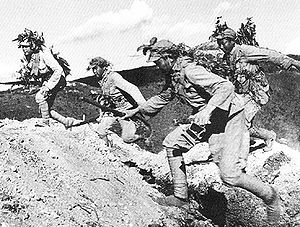Battle of Wanjialing, well known in Chinese text as the Victory of Wanjialing (simplified Chinese: 万家岭大捷; traditional Chinese: 萬家嶺大捷; pinyin: Wànjiālǐng Dàjíe) refers to the Chinese Army's successful engagement during the Wuhan theatre of the Second Sino-Japanese War against the Japanese 101st and 106th Divisions around the Wanjialing region in 1938.
Combatants[]
Chinese[]
In the Battle of Wanjialing, the Chinese side consisted of the 4th Army, the élite 74th Army, 66th Army, 187th Division, 91st Division, New 13th Division, 142nd Division, 60th Division, Reserved 6th Division, 19th Division, a brigade from the 139th Division and the New 15th Division, which totals up to 100,000 men. The chief commander in the frontline was the commander of the 9th Group Army Wu Qiwei. They were under the overall command of the supreme commander of the 9th Military Region Xue Yue.
Japanese[]
The Japanese side consisted of the 106th Division, led by lieutenant-general Junrokurō Matsuura. Under the 106th Division, there were the 111th Infantry Brigade (113th and 147th Infantry Regiments) and 136th Brigade (123rd and 145th Infantry Regiments), as well as Regiments of cavalry, artillery, engineers and transport. Reinforcing the 106th division were the 9th, 27th and 101st divisions.[1]
The battle[]
Under the orders of Yasuji Okamura, the Japanese 106th Division intended to cross the Wanjialing Region in hopes of cutting off the connection between the Chinese Army in Nanxun and Wuning Railway. The plan was discovered by Xue Yue, and the Chinese Army managed to surround the 106th Division with 16 divisions at Lushan. On August 20, the Japanese 101st division amphibiously landed at Xingzi in an attempt to relieve the surrounded 106th division, but faced fierce resistance from the Wang Jingjiu's 25th corps and Ye Zhao's 66th corps. Unable to break through the Chinese lines, Japanese deployed poison gas in an attempt to break through, and, although the Chinese army was sorely lacking in protective equipment against chemical weapons, were still unable to break through the Chinese lines. At the beginning of September, Okamura ordered the 9th and 27th Divisions to relieve the 106th Division, but they were halted by the Chinese Army. On September 24, the Japanese army finally managed to punch through the Chinese lines in the west, but were then confronted by Ou Zhen's 4th corps and Yu Jishi's elite 74th corps and were once again surrounded. Desperate to break open a safe path for their trapped ground forces, the Japanese Air Force began heavy bombing on the Chinese positions with incendiary bombs, resulting in many Chinese deaths.
On October 7, the Japanese divisions were suddenly struck by fierce counter-offensives by the Chinese army. The Japanese divisions had accumulated tremendous casualties by now, and the remaining units which were still intact hastily retreated. The two and a half month battle was finally over, ending in a decisive Chinese victory. The date was the October 10, which was coincidentally the Chinese National Celebration Day. On October 13, 1938, the Chinese forces withdrew from the battlefield.
At the beginning of the battle, Japanese 101st and 106th divisions had a combined strength of over 31,000 troops. By the end of the battle, only a little over 1,000 troops had escaped the encirclement of the Chinese army, the rest being killed or captured. During this battle, not only did the Japanese suffer very heavy casualties, they also experienced a large shortage of officers as a result of the heavy fighting. In fact, throughout the battle, Japanese general Shunroku Hata had to constantly airdrop officers onto the bases of his surrounded units.
The Battle of Wanjialing was a major victory for the Chinese and the first time a full Japanese division had been destroyed.[1]
References[]
- ↑ 1.0 1.1 1.2 1.3 Documentary: The Battle of Wuhan http://www.youtube.com/watch?v=PGM-QARKzIg
Sources[]
The original article can be found at Battle of Wanjialing and the edit history here.
